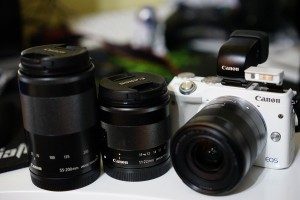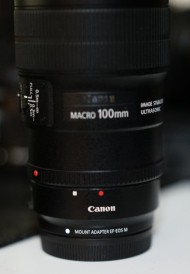I had the original Canon EOS-M and it was a pretty OK camera despite the very slow autofocus function. The concept was sound; it was a mirrorless camera with the same APS-C sized sensor (1.6x crop of a full-frame 35mm camera) found in Canon’s 650D DSLR and could hold any lens that Canon has ever released, thanks to its EF/EF-S to EF-M Adapter.
Most people may not like the EOS-M, but I appreciated it for one thing: it’s a great travel camera. I lugged around a Canon 6D along with a few lenses in most of my trips and it was very tiring.
 Canon released the EOS M3 and it now has the same sensor as the newer 750D and 760D DSLR and also a better AF system, which is about 6x faster than the original EOS-M. In the Philippines, they’re selling it at these SRPs:
Canon released the EOS M3 and it now has the same sensor as the newer 750D and 760D DSLR and also a better AF system, which is about 6x faster than the original EOS-M. In the Philippines, they’re selling it at these SRPs:
Kit Lens Options:
18-55 Kit = 25,998.00 PHP (561.47 USD)
18-55/22 Kit = 33,498.00 PHP (723.44 USD)
18-55 / 55-200 Kit = 40,498.00 PHP (874.62 USD)
If you want to see the complete features and specifications of the new EOS-M3, click here. The more noteworthy ones are:
- 24.2 Megapixel APS-C Sensor
- DIGIC 6 Digital Image Processor
- Can shoot 4.2 frames per second continuously
- Has a 3-inch touch screen display
- Has NFC and WiFi for syncing with any Smartphone.

I had mine picked up in Japan and got the 15-55 / 55-200 Kit for 107,770 JPY which roughly converts to 40,019.69 PHP (864.29 USD). I’m glad Philippine prices are now matched with international SRPs and at least you get the full warranty coverage. But the advantage in buying it from Japan is getting this practically free of charge: the EVF-DC1.
The EVF-DC1 electronic viewfinder costs about 11,500 PHP (250 USD) so I’m glad I didn’t have to pay extra for this little accessory. Without this thing, it is hard to see what you’re taking pictures of in broad daylight.
Here are a few sample pics I took with the EOS-M3:
 There were a lot of times that I wished I had brought both an ultra wide lens for landscapes and a telephoto one for something far off. But I always ended up leaving one because of the weight. The current EF-M line lenses pretty much cover all the base focal lengths and although they may not be as good as their big brothers, they do get the job done. I won’t have second thoughts in packing them all for a trip. You can see how small these lenses are compared to their DSLR counterparts.
There were a lot of times that I wished I had brought both an ultra wide lens for landscapes and a telephoto one for something far off. But I always ended up leaving one because of the weight. The current EF-M line lenses pretty much cover all the base focal lengths and although they may not be as good as their big brothers, they do get the job done. I won’t have second thoughts in packing them all for a trip. You can see how small these lenses are compared to their DSLR counterparts.
 Even if you’ve invested in EF or EF-S lenses and don’t want to spend more for specialized ones for the M3, Canon’s official EF to EF-M adapter is a must have. I bought this for around 5,000 PHP (108 USD). Compared to the usual third-party solutions at this price point, you retain full autofocus functionality with any lens you plug this thing into.
Even if you’ve invested in EF or EF-S lenses and don’t want to spend more for specialized ones for the M3, Canon’s official EF to EF-M adapter is a must have. I bought this for around 5,000 PHP (108 USD). Compared to the usual third-party solutions at this price point, you retain full autofocus functionality with any lens you plug this thing into.
Now this camera is definitely not for everybody. Most professionals would rather get a second DSLR while casual photographers will probably use a normal point-and-shoot. What the EOS-M3 does for me is fill the gap between my general purpose iPhone camera and my 6D. It’s small and light enough to bring as a secondary body when I want to shoot with an ultra wide or a telephoto lens without having to worry about losing my ability to shoot with a full-frame camera.






